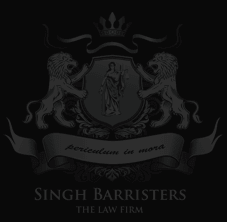| Toll Free : 1844 495 7333(injury hotline- new cases only) | |
| Text a Personal Injury Lawyer 24/7 and get instant help.TM (416 931 5015) | |
| Head Office : 905 495 7333 |
Personal Injury Lawyer’s Fees: How Much Will I Have To Pay?
October 1, 2017
Brampton personal injury lawyers often meet potential clients who are concerned about the kind of fees that they will have to pay us if they hire us to pursue their case. This is a very natural apprehension and we make every effort to ensure that our clients receive detailed, clear, transparent information about every aspect of the case, including fees.
Clients are also confused about the different rates charged by different lawyers and law-firms. As with all professionals, there is a governing body to regulate lawyers, viz., in this case, the Law Society of Upper Canada, but there is no regulation on the fees that lawyers are allowed to charge. Hence, the rates can vary according to area of practice, experience, reputation, knowledge etc. with certain exceptions like minors or people with disabilities. In general, the more serious the injuries, the more important it is to hire an experienced, knowledgeable personal injury lawyer.
How Fees Can Be Calculated
In a landmark case in 2000, the Ontario Court of Appeal listed the considerations taken into account while fees are calculated:
- Time spent
- Legal complexity of case
- Degree of involvement in case
- Monetary value of the case
- Importance to the client
- Skills and competence of lawyer
- Results
- Ability of client to pay
- Client’s expectation of a reasonable fee
Almost 95% of personal injury lawyers charge their clients what is known as a contingency fee. This means that no fees have to be paid upfront. Instead, the lawyer or law-firm assumes full financial responsibility in the case, including in many cases, funding medical and household expenses. Many lawyers also provide the No-Win No-Fee contingency. This means that only expenses have to be paid in case of an unsuccessful outcome.
This system is designed to benefit those litigants who are genuinely unable to afford legal services. It allows them to pursue a case which they may otherwise have been unable to do. The lawyer gets paid a percentage of the settlement amount. In general, this would be about 33% of the final settlement amount, but some lawyers may charge between 20-25% plus costs though this is a moot point under the Ontario Solicitors Act. “Costs” refers to expenses like accessing police, traffic, medical records, hiring witnesses, conducting independent investigations, filing fees, serving summonses/subpoenas, expert witness fees, court fees etc.
The contingency fee agreement has to be put in writing and clearly understood by the client. Verbal agreements are not recognized by the law. The contract has to also clearly specify that the client was given the choice of hiring the lawyer on an hourly basis or a contingency basis. The client must be fully involved in making critical decisions.
Settlements are typically divided into the claim portion, costs portion and third-party disbursements. The entire settlement amount paid by the at-fault party is to be paid to the client who then gives the agreed percentage of it to the lawyer.
Our experienced Brampton car accident lawyers and Brampton slip and fall injury lawyers can explain the fee structure in complete detail and answer all your concerns and queries.
Personal Injury Lawyer’s Fees: How Much Will I Have To Pay?
October 1, 2017
Brampton personal injury lawyers often meet potential clients who are concerned about the kind of fees that they will have to pay us if they hire us to pursue their case. This is a very natural apprehension and we make every effort to ensure that our clients receive detailed, clear, transparent information about every aspect of the case, including fees.
Clients are also confused about the different rates charged by different lawyers and law-firms. As with all professionals, there is a governing body to regulate lawyers, viz., in this case, the Law Society of Upper Canada, but there is no regulation on the fees that lawyers are allowed to charge. Hence, the rates can vary according to area of practice, experience, reputation, knowledge etc. with certain exceptions like minors or people with disabilities. In general, the more serious the injuries, the more important it is to hire an experienced, knowledgeable personal injury lawyer.
How Fees Can Be Calculated
In a landmark case in 2000, the Ontario Court of Appeal listed the considerations taken into account while fees are calculated:
- Time spent
- Legal complexity of case
- Degree of involvement in case
- Monetary value of the case
- Importance to the client
- Skills and competence of lawyer
- Results
- Ability of client to pay
- Client’s expectation of a reasonable fee
Almost 95% of personal injury lawyers charge their clients what is known as a contingency fee. This means that no fees have to be paid upfront. Instead, the lawyer or law-firm assumes full financial responsibility in the case, including in many cases, funding medical and household expenses. Many lawyers also provide the No-Win No-Fee contingency. This means that only expenses have to be paid in case of an unsuccessful outcome.
This system is designed to benefit those litigants who are genuinely unable to afford legal services. It allows them to pursue a case which they may otherwise have been unable to do. The lawyer gets paid a percentage of the settlement amount. In general, this would be about 33% of the final settlement amount, but some lawyers may charge between 20-25% plus costs though this is a moot point under the Ontario Solicitors Act. “Costs” refers to expenses like accessing police, traffic, medical records, hiring witnesses, conducting independent investigations, filing fees, serving summonses/subpoenas, expert witness fees, court fees etc.
The contingency fee agreement has to be put in writing and clearly understood by the client. Verbal agreements are not recognized by the law. The contract has to also clearly specify that the client was given the choice of hiring the lawyer on an hourly basis or a contingency basis. The client must be fully involved in making critical decisions.
Settlements are typically divided into the claim portion, costs portion and third-party disbursements. The entire settlement amount paid by the at-fault party is to be paid to the client who then gives the agreed percentage of it to the lawyer.
Our experienced Brampton car accident lawyers and Brampton slip and fall injury lawyers can explain the fee structure in complete detail and answer all your concerns and queries.









